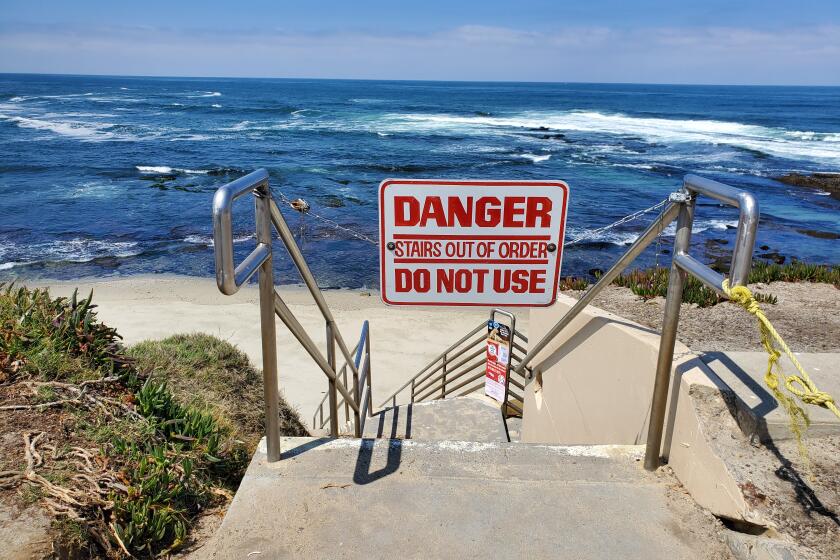Meet San Diego’s new police chief David Nisleit: Visit to La Jolla reveals his plans for law and order
It’s been less than 60 days since David Nisleit was promoted to San Diego’s 35th Chief of Police, but he is already making the rounds to San Diego’s communities, including La Jolla. Nisleit, along with Northern Division Captain Tina Williams and a collection of San Diego’s finest, gathered at the La Jolla Library April 30 for a Town Hall-style meeting to get to know the new chief.
Nisleit answered questions about everything from dockless bikes to racial profiling, and outlined his goals and expectations for the police department.
Born and raised in San Diego, Nisleit said he spent the last 30 years with the police department. He was appointed Chief of Police by Mayor Kevin Faulconer on March 2. According to his bio, his father served over 35 years with the department and retired as a captain in 1999. His son, Ryan, recently graduated from the San Diego Police Academy, and is currently a patrol officer. Chief Nisleit is also a professor of criminal justice at the University of San Diego and Alliant University. In his spare time, he said he enjoys running, cycling, golf and spending time with his wife, three kids and grandson.
His history with the department includes patrol duties at Central Division, which includes Balboa Park and Little Italy; terms on the SWAT team, climbing to the rank of sergeant; narcotics and sex crimes; the beach patrol at Northern Division; handling special events such as Comic-Con and the San Diego Pride Parade; and assistant chief of patrol operations for a year-and-a-half until his most recent promotion.
Approaching the post with a “help us help you” and “if you see something, say something” attitude, he encouraged residents to make use of the San Diego Police Department’s non-emergency phone line: (619) 531-2000, to report suspicious activities. Integrating an occasional joke into his introductory remarks, when asked how to pronounce his last name, he said “Jones” (It’s Niss-Light, by the way).
Quality-of-life issues
Eight days into his tenure as Chief, Nisleit said he initiated a Neighborhood Policing Division. “I created that new division to address quality-of-life issues that are impacting so many communities from the border to the wild animal park.” He said the intent is to have one voice and one office to handle issues across community divisions, rather than having each division handle things differently.
But he hopes his legacy, he said, is a complete rebuild of the San Diego Police Department: “I know that’s a lofty goal. When I came on in 1988 to put someone in jail for a felony took less than two hours. Let’s just say it’s not two hours today. It’s probably double that, the paperwork is probably double that. The laws have changed. I want to look at re-staffing the police department and blend old-school policing, like the old beat cop shows on TV, with new technology that is going to be a force multiplier for us as a department.
“There are so many different things that allow a police officer to do their job efficiently and effectively. The technology exists, but it takes a lot of money (to get it) and we have officers working on old-model computers. We are looking at getting tablets and more communication technology, but that costs money.”
When asked about staffing, and what’s being done to get the police department to desirable numbers, Nisleit said he would use the $28 million in salary and benefit increases as part of the recruitment and retention package outlined in Mayor Faulconer’s proposed budget for Fiscal Year 2019.
“We are very appreciative of the competitive pay package, but at the end of the day, we are 240 officers down in the San Diego Police Department right now, and I still have 600 officers who are eligible to retire over the next five years, so it makes me have to hire a lot of officers and do what I can to keep them in house now. The pay package is a game changer and levels the playing field. We should be able to turn the table and start re-staffing the police department and getting back to the bread and butter of community policing — seeing more officers on foot and on bike and addressing community concerns.”
Dockless bikes and scooters
When asked about the safety concerns brought to light with the proliferation of dockless bikes, such as riders on sidewalks and without helmets, Nisleit said he would “look forward to having” a meeting with the bike-share companies to discuss safety rules and enforcement. “I know it’s going to happen because we have heard grumblings about that and we are working very hard. Northern Division and Traffic Division are running some policies to address the different issues on City streets and we’re receiving a ton of phone calls about those issues.”
Addressing reckless driving and speeding throughout town, Northern Division’s Captain Williams said she was looking to get traffic trailers that have red and blue police lights and show the rate of speed someone is going. “We’re trying to get the funding to place them in different areas where people are notorious for speeding,” she said.
Nisleit added: “We make thousands of traffic stops a month throughout the City, I will say traffic stops annually are down, but that has something to do with attrition. I, as the Chief of Police, have made traffic stops. I get teased about it, but it is something we are doing in Northern Division.”
Lastly, he addressed the approval of Assembly Bill 953, which deals with racial profiling in law enforcement. The bill, in part, changes the definition of racial profiling to “instead refer to racial or identity profiling, and make a conforming change to the prohibition against peace officers engaging in that practice” (according to the bill’s text).
The San Diego Police Department must be in compliance by July 1, and would use software created by the Sheriff’s Department to broaden data fields to collect more information.
“It is going to let us take more into consideration in painting a bigger picture in the field, and what’s going on with how we respond to crime,” Nisleit said. Addressing traffic stops in particular and “disparities in searches,” he added: “In certain parts of town, our gang suppression team recovered more than 100 weapons — firearms not knives — during traffic stops. To me, not only are traffic stops a means of addressing traffic issues, they address violent crime. How many murders did we stop or armed robberies did we prevent by doing that?”
Nisleit concluded by saying he wants the police department to be transparent, and encouraged anyone with questions, comments or concerns to contact him and learn more about the police department via sandiego.gov/police
Get the La Jolla Light weekly in your inbox
News, features and sports about La Jolla, every Thursday for free
You may occasionally receive promotional content from the La Jolla Light.




